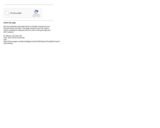
This is a handout I have used to help faculty identify and use Open Educational Resources.
- Subject:
- Education
- Material Type:
- Diagram/Illustration
- Author:
- David O. Smith
- Date Added:
- 02/02/2021

Resources under the keyword "Colorado".

This is a handout I have used to help faculty identify and use Open Educational Resources.
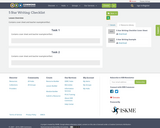
Contains cover sheet and teacher example/artifact.
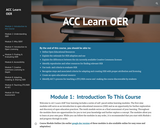
Austin Community College (ACC) Learn OER includes a series of self-paced online learning modules. The first nine modules will serve as an introduction to open educational resources (OER) and as an opportunity for further exploration and discovery of open education practices. The tenth module serves as a final assessment of your learning. Throughout the modules there are opportunities for you to test your knowledge and further explore a concept. The modules allow you to learn at your own pace. While you can follow the modules in any order, it is recommended that you start with Module 1 and progress through in order.
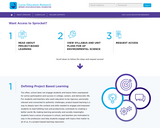
This course contains five projects, plus a course introduction and course closure, that are organized around the following question: “How can we rethink our use of the world’s resources?” Each project involves investigations of sustainability that help contextualize the content required by the new College Board course framework.
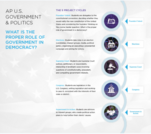
This course contains five projects that are organized around the following question: “What is the proper role of government in a democracy?” Each project involves political simulations through which students take on roles that help contextualize the content required by the new College Board course framework.
Founders' Intent
Elections
Supreme Court
Congress
Government in Action
Openly licensed PDF unit plans of all the above units are available at this Sprocket Lucas Education Research Platform (scroll to bottom of web page).
Alternately, educators may sign up for free access to the online AP U.S. Government and Politics course that includes additional instructional supports:
https://sprocket.lucasedresearch.org/users/sprocket_access

Acceso is a complete, interactive curriculum for intermediate-level learners of Spanish. The materials on the site are provided freely to the public and are intended as a replacement for commercial textbooks, which are generally ill-suited to the learning outcomes now considered crucial to successful language study. These materials are supplemented by an online workbook built on the MySpanishLab platform of Pearson Education, Inc., as well as detailed lesson plans, rubrics for the evaluation of student work, and reliable instruments for measuring student progress and learning outcomes. Winner of 2012 Computer Assisted Language Consortium (CALICO) Focus Award
Reviews
CALICO Journal 29.2 (Jan 2012): 398-405.
Hispania 95.2 (June 2012): 365-366

Classification of Analytical Methods

A comprehensive collection of documents originally created to assist human services professonals and regional training academies with creating accessible content, including guides, walkthrough videos, checklists and practice documents.Navigate between sections using the dropdown menu at the top of the page!

This animation seeks to lead students to a deeper understanding of the challenges that come with online learning for those with disabilities, and a newfound or renewed sense of empathy towards others.
Music by VYEN.
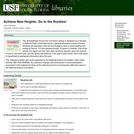
Spreadsheets Across the Curriculum module/Geology of National Parks course. Students estimate travel times and costs of a driving/camping trip to visit national parks in Colorado.
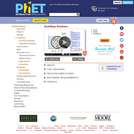
How do strong and weak acids differ? Use lab tools on your computer to find out! Dip the paper or the probe into solution to measure the pH, or put in the electrodes to measure the conductivity. Then see how concentration and strength affect pH. Can a weak acid solution have the same pH as a strong acid solution?
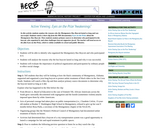
In this activity students analyze the reasons why the Montgomery Bus Boycott lasted so long and was successful. Students watch a short clip from the PBS documentary Eyes on the Prizeabout the Montgomery Bus Boycott. Then students analyze primary sources to determine who participated in the boycott, who organized it, and what challenges boycott supporters faced. The teacher will need access to the filmEyes on the Prize, which is widely available in school and public libraries.
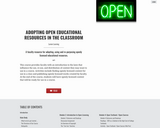
VCCS's "Pathways" Course provides faculty with an introduction to the laws that influence the use, re-use, and distribution of content they may want to use in a course. Activities include finding openly licensed content for use in a class and publishing openly licensed works created by faculty. At the end of the course, students will have openly licensed content that will be ready for use in a course.
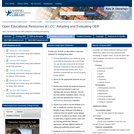
As faculty, you assess textbooks against a set of criteria that reflects your long experience and knowledge of student needs. You do the same with Open Textbooks, but there are a few additional considerations.
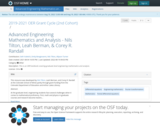
An open-source textbook covering vector calculus, ordinary and partial differential equations, and Fourier series. The textbook is used in a first-year graduate level course in the Department of Mechanical Engineering at the Colorado School of Mines. It undergoes extensive revisions annually, but is relatively complete.

Students engage in hands-on, true-to-life research experiences on air quality topics chosen for personal interest through a unit composed of one lesson and five associated activities. Using a project-based learning approach suitable for secondary science classrooms and low-cost air quality monitors, students gain the background and skills needed to conduct their own air quality research projects. The curriculum provides: 1) an introduction to air quality science, 2) data collection practice, 3) data analysis practice, 4) help planning and conducting a research project and 5) guidance in interpreting data and presenting research in professional poster format. The comprehensive curriculum requires no pre-requisite knowledge of air quality science or engineering. This curriculum takes advantage of low-cost, next-generation, open-source air quality monitors called Pods. These monitors were developed in a mechanical engineering lab at the University of Colorado Boulder and are used for academic research as well as education and outreach. The monitors are made available for use with this curriculum through AQ-IQ Kits that may be rented from the university by teachers. Alternatively, nearly the entire unit, including the student-directed projects, could also be completed without an air quality monitor. For example, students can design research projects that utilize existing air quality data instead of collecting their own, which is highly feasible since much data is publically available. In addition, other low-cost monitors could be used instead of the Pods. Also, the curriculum is intentionally flexible, so that the lesson and its activities can be used individually. See the Other section for details about the Pods and ideas for alternative equipment, usage without air quality monitors, and adjustments to individually teach the lesson and activities.
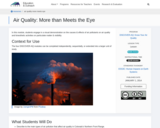
In this module, students engage in a visual demonstration on the causes & effects of air pollutants on air quality and kinesthetic activities on particulate matter & visibility.
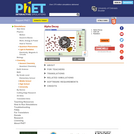
Watch alpha particles escape from a polonium nucleus, causing radioactive alpha decay. See how random decay times relate to the half life.
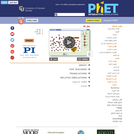
Watch alpha particles escape from a polonium nucleus, causing radioactive alpha decay. See how random decay times relate to the half life.

An interview conducted by the ACLU in March of 2005, preceding a Supreme Court hearing in the case of Castle Rock, Colorado v. Gonzales. This case determined the accountability of local law enforcement for failing to enforce court orders that protect victims of abuse by a spouse or acquaintance.